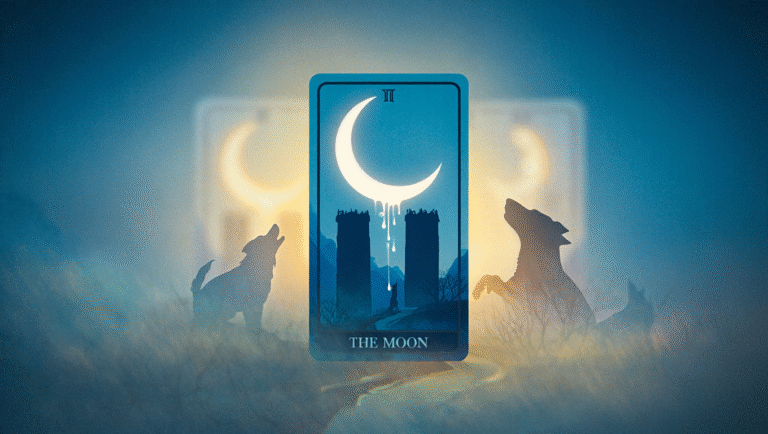Lesson 6: Celtic Cross Spread
If you’ve ever unboxed a tarot deck and found yourself staring at the little white booklet, you’ve probably seen the Celtic Cross spread. It’s the “classic” 10-card layout, famous for a reason—but also kind of intimidating the first time you try it. In this guide, I’ll walk you through setting up the Celtic Cross in just 15 minutes, share honest tips for reading each position (without needing to channel Merlin), and offer a simple cheat sheet you can use every time. Whether you’re new to tarot or want to go deeper than “past, present, future,” this one’s for you.
Why the Celtic Cross Endures: Context for Modern Readers
The Celtic Cross has been around for over a century, popularized by the Rider-Waite-Smith deck. It’s used by beginners and pros because it covers pretty much every angle of a question: your current situation, influences, obstacles, subconscious drives, future possibilities, and more. But let’s be honest—ten cards is a lot, and the layout diagram in the booklets often makes it look more cryptic than it needs to be.
Here’s the good news: you don’t need to memorize all the “traditional” meanings or be psychic to use this spread. What you do need is a little structure, a way to break the spread down, and a willingness to trust your own observations.
Case Study: My First Real Celtic Cross Reading
I’ll never forget my first “serious” Celtic Cross. I was asking about a big career shift—should I quit my safe job and go freelance? The spread felt huge and overwhelming. But breaking it down, card by card, made it manageable. I realized the positions were sneakily logical: my anxieties (card 3) were showing up as blocks (card 4), but my support network (card 6) and my own skills (card 7) were stronger than my fears. I didn’t get an oracle’s answer, but I did get a roadmap. Spoiler: I made the leap six months later. No regrets.
“The Celtic Cross is less about magic, more about making sense of chaos.”
How To Do a Celtic Cross Spread in 15 Minutes
Here’s a step-by-step approach you can use with any tarot deck. Set a timer if you want to keep things focused!
What You’ll Need
- Your favorite tarot deck
- Journal or notepad (optional, but recommended)
- Quiet space for 15 minutes
1. Shuffle & Focus (2 minutes)
Think of your question. Be as specific as you can—vague questions get vague answers. Shuffle your cards as you focus. When you feel ready, stop.
2. Lay Out the Cards (3 minutes)
Lay out the cards in the classic Celtic Cross pattern:
- The Significator: The heart of your situation.
- The Crossing: What challenges or supports you.
- The Foundation: What’s beneath the surface; subconscious roots.
- The Recent Past: What’s just behind you.
- The Crown: Hopes, goals, or what could be achieved.
- The Near Future: What’s coming next.
- You: How you see yourself in this situation.
- Your Environment: Outside influences, people, context.
- Hopes and Fears: What you wish for or worry about.
- Outcome: The likely direction things are headed.
3. Interpret, Position by Position (10 minutes)
- Cards 1-2: Read together as a snapshot of the present and what’s helping or hindering.
- Cards 3-6: These four cards show why you’re here and where you might be going next.
- Cards 7-10: The “vertical” (staff) cards are all about you, your mindset, and the world around you.
Don’t overthink! If a card stumps you, jot down the image, color, or word that stands out. Sometimes the best insights come from your gut, not the guidebook.
Quick Reference: Celtic Cross Cheat Sheet
| Position | What It Represents | Interpretation Tip |
|---|---|---|
| 1 | Significator (You/Present) | What’s the core of your question? |
| 2 | The Crossing (Challenge/Support) | Is this a block or a boost? |
| 3 | Foundation (Subconscious/Origin) | Hidden roots, past patterns |
| 4 | Recent Past | What’s fading out? |
| 5 | Crown (Goal/Potential) | Your “best case” scenario |
| 6 | Near Future | Immediate next steps |
| 7 | You | Your role, attitude |
| 8 | Environment | People, places, energies around you |
| 9 | Hopes & Fears | Sometimes both at once! |
| 10 | Outcome | Probable direction, not set in stone |
Choosing the Right Tarot Deck for Celtic Cross
While any deck works, some are easier to read with this spread—especially those with clear imagery and guidebooks. Here’s a quick comparison of top starter decks for the Celtic Cross layout:
| Name | Key Feature | Size/Material | Price Range | Amazon Link |
|---|---|---|---|---|
| Rider-Waite-Smith | Classic, universal imagery | Standard, cardstock | $18–$25 | See today’s deal |
| Modern Witch Tarot | Diverse, modern illustrations | Standard, sturdy | $20–$30 | Check price on Amazon |
| Light Seer’s Tarot | Contemporary, intuitive art | Standard, matte | $18–$25 | See today’s deal |
- Rider-Waite-Smith: Best for learning, tons of resources online. Pros: Classic, affordable. Cons: Older art style may feel dated.
- Modern Witch Tarot: Great for those wanting a fresh, inclusive vibe. Pros: Modern, easy to interpret. Cons: Slightly thicker cards.
- Light Seer’s Tarot: Excellent for intuitive readers. Pros: Vibrant, emotional images. Cons: More abstract, not for strict traditionalists.
Pro Tips: Making the Celtic Cross Work for You
- Use a cloth or mat to keep your layout organized. Try this affordable tarot cloth.
- Snap a photo of your spread to reflect later—no shame in using your phone.
- Set a timer if you tend to overthink. 15 minutes is plenty for a first pass.
- Journal your impressions—not just “meanings,” but what you feel or notice.
- Try apps like Labyrinthos for free Celtic Cross practice, or Biddy Tarot’s guide for deeper dives.
Who Should Use the Celtic Cross?
- *Great for*: Big life decisions, complex situations, when you want a “360 view.”
- *Maybe skip for*: Quick check-ins, yes/no questions (try a 3-card spread instead).
15-Minute Celtic Cross Checklist
- Set a clear question
- Shuffle and lay out 10 cards in order
- Read cards 1-2 together, then 3-6 (story), then 7-10 (advice)
- Take a photo or notes
- Reflect—ask “What’s the biggest ‘aha’ here?”
Conclusion: Keep It Simple, Stay Curious
The Celtic Cross is a classic for a reason, but it’s not about perfection or mystical secrets. It’s a tool for clarity—a way to see your situation from every angle, with a little help from your cards and your own intuition. The more you practice, the easier it gets (and the less intimidating those ten-card layouts feel).
Want to upgrade your toolkit? Grab a new deck, try a card mat, or check out a tarot app to log your spreads. And always, always trust your own process—you can’t “fail” at tarot if you’re showing up with honesty and curiosity.
Some links may be affiliate. You pay the same price, and this blog may earn a small commission.




